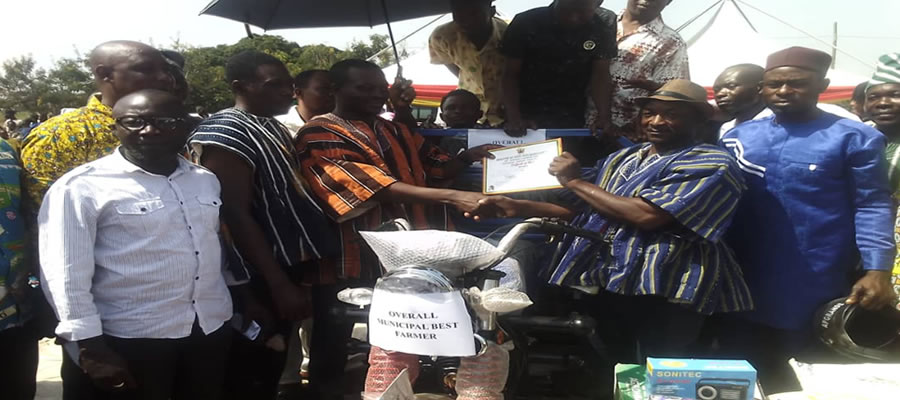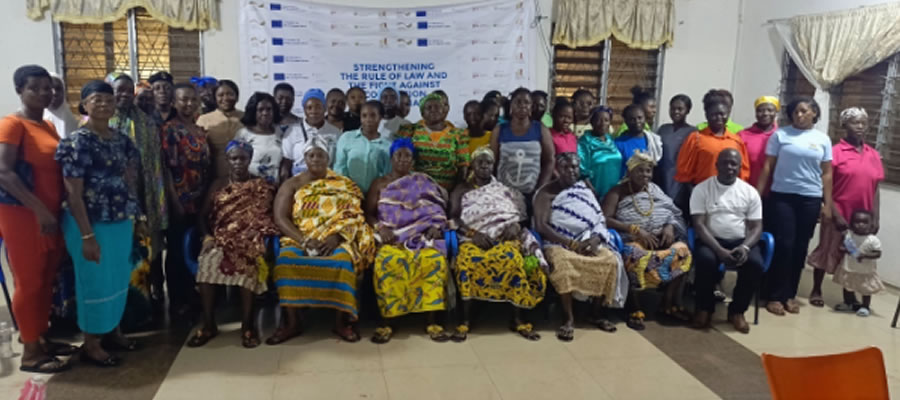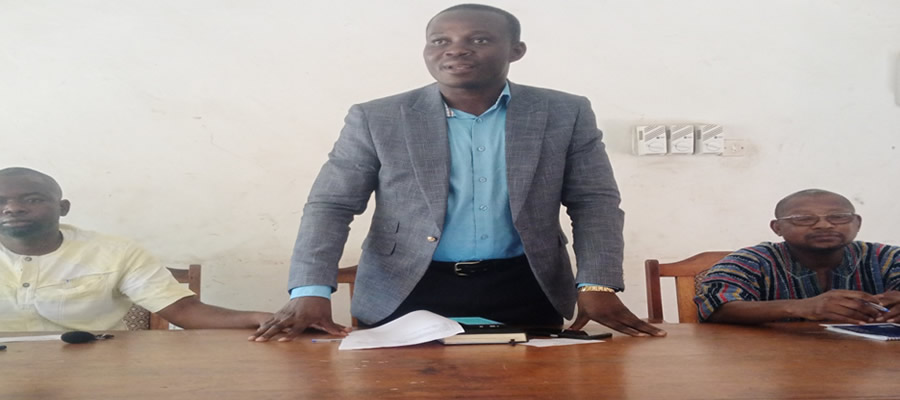

In linking to the overall municipal goal which states that, it is to become a hub of socio-economic activities that seeks to improve the wellbeing of its citizenry through sustainable development. It is worth noting that the implementation of activities and strategies under this dimension build a prosperous society. Some of these areas include
Internally Generated Fund (IGF)
The internally generated fund of the Assembly is the only reliable source of funding for recurrent and capital expenditures. Due to this the assembly has employed strategies including widening the tax net in order to increase the financial base of the assembly. This led to the assembly undertaking physical projects such as completion of female ward (40 bed seater capacity) at the Atebubu Government Hospital, constructed municipal court complex, completed the NHIS Office Block, renovated the Atebubu Main Market and many others. Reviews indicate that, IGF continue to perform better as compared to previous years. In 2018 (GH?1,676,738.02), IGF shot up by 68.30% in comparing with the 2017 (GH?996,237.30) fiscal year. In 2019, it revealed that, there was a slight decrease of 0.15%. In absolute figures the following were recorded from 2017 to 2020.
From the chart above, it is clear that, the revenue increased from 2017 to 2018, dropped marginally in 2019 but shot up in 2020.
Other Funding Sources
DACF
On District Assembly Common Fund (DACF), in comparing 2017 and 2018 releases, there was a fall indicating 8.7 percentage decrease. It increased marginally from 2018 to 2019 by 15.6%. it further increased by 26.5% in 2020. In 2021, the drop was huge with 64% decrease which was being attributed to the effect of the COVID-19.
People Living with Disability Fund (PWD)
In 2018, there was an increase in release a little bit higher than the target. It dropped marginally in 2019. The decrease continued in 2020 as well as 2021 with a drop of 39.4 percent. The continuous decrease in its release shows that, the Assembly will not be able to meet the felt needs of these vulnerable people in terms of education, health, economic among others.
Economy of the District
The Municipal has an average household size of 5.1, and an average of 5.2 people per household. This translates into an average of 26 people per house.
Household Income Pattern
The average annual income for an average household size of five for the sampled population is GH¢912.4572 and this translates into an average per capita annual income of GH¢182.4914. Majority of the people draw their income from agriculture (66%), and salaries (13%) commerce and services (12%), and to a lesser extent industry (9%). Income levels are generally low throughout the Municipal as compared to the national average income per head of GH¢595.26 (i.e. $390 at GH¢ 1.45). There is the need to develop the major sectors of the economy, especially agriculture, through effective storage, processing and marketing of produce.
Income Distribution
High inequalities exist in the distribution of income in the district. Using the Lorenz Curve (See Figure 4). The Gini- concentration coefficient was found to be 0.47, indicating a situation of unfair distribution of income. It also revealed that the lower 24% of the population enjoyed 4% of the income while the top 20% commanded as high as 53% of the Municipal income. Currently, a large proportion of the low income group is found in the agriculture sector. Apart from improving income levels, there is the need to also ensure a fair distribution of income.
Expenditure Pattern
The mean annual household expenditure for the sample population is GH¢1,111.73, while the annual per capita expenditure stands at GH¢222.3668. This compares favorably with the mean national annual per capita expenditure of GH¢98.7.
For an agricultural based economy like the Atebubu-Amantin municipal, it is critical to encourage people to produce what they eat to cut down expenditure on food. This is the easiest way for people to save towards development expenditure, especially for housing improvement.
Poverty levels
The incidence of poverty in Ghana is assessed at two levels: An Upper Level and Extreme Lower Level. The Upper Poverty line in Ghana refers to incomes of up to GH¢90 a year or GH¢75 a month. The extreme poor are people with incomes below GH¢70 a year or GH¢5.8 a month. The latest statistics on poverty estimates that about 40% of the Ghanaian population has incomes below the upper poverty line; while about 27% of the population has incomes below the extreme poverty line.
Based on these cut-off points it has been estimated that 14% of the district’s population are poor whilst 59% are extremely poor. The findings corroborate the fact that poverty in Ghana is a rural phenomenon with the rural areas accounting for more than 70% of the poor. In terms of economic activity, poverty in the Atebubu-Amantin Municipal is by far highest among food crop farmers.
Financial Services
Financial services in the Municipal are provided by about four main banks, and all these financial institutions are concentrated in the only two urban settlements in the district, namely, Atebubu and Amantin. There are other bodies such as BAC and the Association of Productive Entrepreneurs in Development (APED) that complement activities of the banks in the provision of financial services. Apart from these formal financial institutions, informal financial institutions such as ‘Susu Schemes’ and cooperative groups are encouraged in these areas. This will require an effective collaboration between all other institutions in the complementary financial services network.
Local economic development
A formidable micro economy of the Municipal is key to the reduction of extreme poverty. The economy of the Atebubu-Amantin Municipal is dominated by agriculture with commerce and industrial sector the least. About 66 percent of the labor force is engaged in agriculture, commerce account for 11 percent while industry and other sectors account for about 23 percent. Most of the people in the Municipal generate their income from food crop farming such as maize, yam, garden eggs, cassava among others (59%) and other ventures 41%.
With the high dominance of food crop farming as a source of household income in the Municipal which is largely rain fed, there is the need for alternative means of water supply such as dugouts or irrigational facilities to reduce the issues of droughts affecting crops seriously.
Migration (emigration and immigration)
Out-migration is not very prominent in the district. This could be attributed to the fact that about 55% of the total populations are farmers who have access to fertile lands for farming. However, in-migration is very prominent in the district. This could be attributed to the availability of arable land for agricultural activities which has attracted many farmers from the three northern regions. Currently, majority of the settlers in the Municipal are engaged in farming.
Indicative Financial Plan for the MTDP 2018-2021
Based on the IGF collected last year (2017) and internal mechanisms put in place, it is expected that IG will increase by 20% by the end of each year, DACF would be increased by 20% and Irregular receipt of others makes projection below 20%. GOG here considers releases to other departments, Zongo Development Fund and others.
FINANCIAL GAP GH¢
Total cost of Plan -81,773,000.00
Indicative Financial Budget -64,218,062.29
GAP - 17,554,937.71
FINANCING THE GAP
From the analysis above, the total cost of financing the MUNICIPAL Medium Term Development plan (2018-2021) stands at Eighty One Million, Seven Hundred and Seven-Three Thousand Ghana Cedi (GH¢81,773,000.00) against an indicative budget of Sixty Four Million, Two Hundred and Eighteen thousand and Sixty Two Ghana Cedi Twenty Nine pesewas (GH¢ 64,218,062.29). This leaves a gap of Seventeen Million Five Hundred and Fifty four thousand Nine hundred and Thirty -Seven Ghana cedi Seventy One pesewas (GH¢17,554,937.71).
Business Advisory Services
Business Advisory Services are basically provided by the Business Advisory Centre (BAC) under the ambit of the Municipal Assembly. BAC is responsible for providing training, advisory and financial services in the form of loans to existing and aspiring entrepreneurs. The activities of BAC have to some extent contributed to increasing the management and entrepreneurial skills required for running businesses in the district. The target groups for these training are both the unemployed youths and those already employed in small scale industries. The key challenge of BAC is about inadequate funds to expand its outreach programmes as well as meet the financial demands for loans for the small scale business operators.
Financial Services
Financial services in the Municipal are provided by about four main banks, and all these financial institutions are concentrated in the only two urban settlements in the district, namely, Atebubu and Amantin. There are other bodies such as BAC and the Association of Productive Entrepreneurs in Development (APED) that complement activities of the banks in the provision of financial services. Apart from these formal financial institutions, informal financial institutions such as ‘Susu Schemes’ and cooperative groups are encouraged in these areas. This will require an effective collaboration between all other institutions in the complementary financial services network.
Cooperatives
The Department of Cooperatives exists to strengthen the development of groups into viable cooperative societies in the district. It is also responsible for the mobilization, training and monitoring of cooperative societies in the district. Training packages are provided by the department to these groups to enable them to better manage their societies for the benefit of their members. The department also link the societies with potential donor organisations for financial, technical, material support and audit all cooperative society registered under it. The Department of Cooperatives currently deal with 39 registered cooperative societies and six (16) unregistered cooperative entities.
The Department of Cooperatives encounters a lot of problems that affect its work in the district. The Department is run by a single person. Other problems of the department include inadequate logistics like computers, cabinet for data storage, lack of funds and lack of transport facilities to reach out to cooperative societies and monitor their activities.
Date Created : 11/21/2017 7:04:29 AM












 facebook
facebook
 twitter
twitter
 Youtube
Youtube
 +233 593 831 280
+233 593 831 280 0800 430 430
0800 430 430 GPS: GE-231-4383
GPS: GE-231-4383 info@ghanadistricts.com
info@ghanadistricts.com Box GP1044, Accra, Ghana
Box GP1044, Accra, Ghana